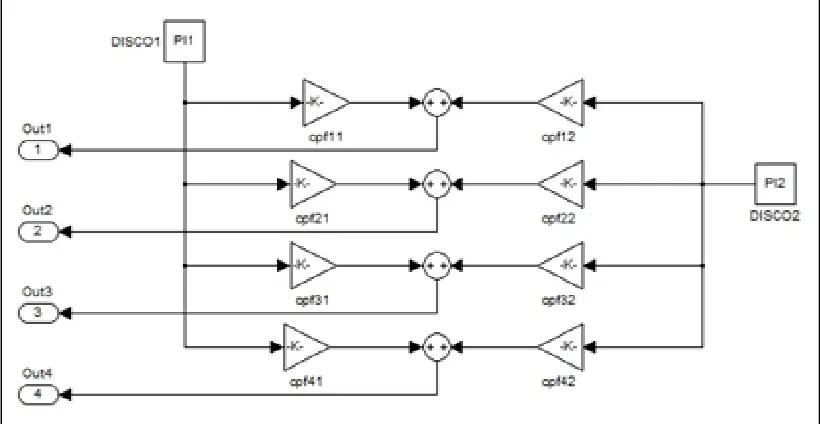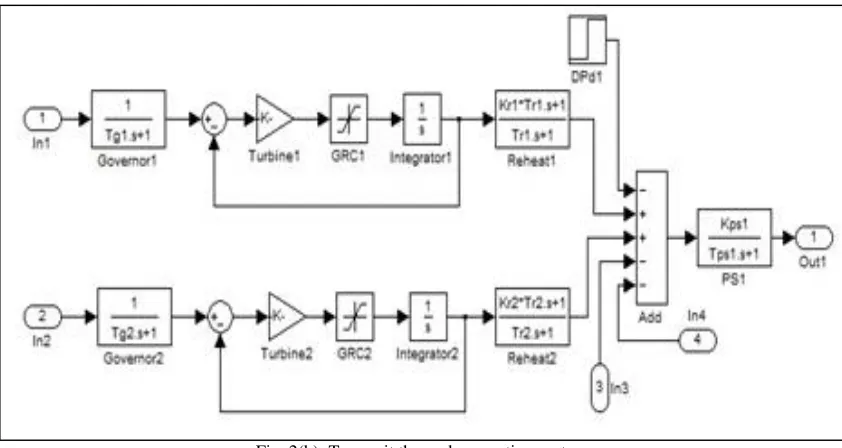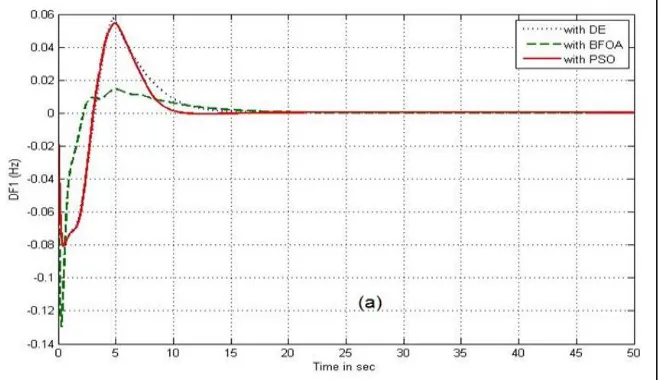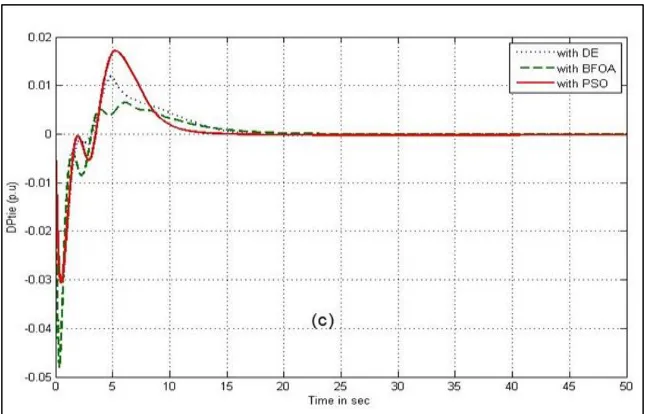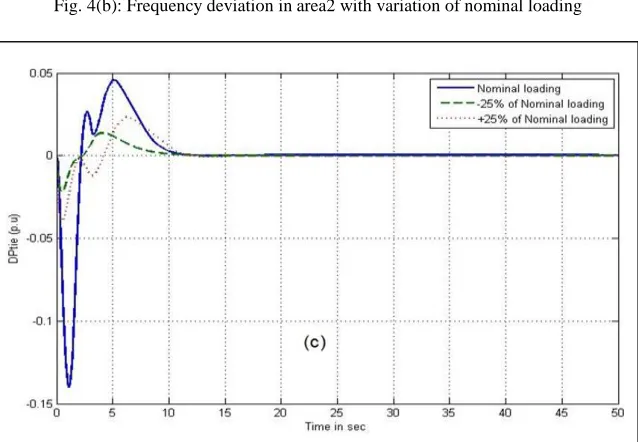PSO Optimized Load Frequency Control of a
Multi Area Power System under Restructured
Scenario
D. Siva Dr. Y. Butchiraju
PG Student Professor
Department of Electrical & Electronics Engineering Department of Electrical & Electronics Engineering Sir C.R.R College of Engineering, Eluru, India Sir C.R.R College of Engineering, Eluru, India
Abstract
In power systems, Load Frequency Control is the main goal to maintain the power system frequency of each area and tie line power at a stable condition. In this paper a Proportional Integral with Derivative Filter (PIDF) is proposed to get an accurate result of Load Frequency Control (LFC) problem. With this PIDF controller the system considering some important physical constraints such as Generation Rate Constraint (GRC) and Time Delay (TD) are considered and the parameters are tuned using Particle Swarm Optimization (PSO) technique considering an objective function Integral Time multiplied Absolute Error (ITAE). The performance of proposed PIDF controller using PSO optimization technique is valuate at different operating conditions that takes place in restructured scenario.
Keywords: Load Frequency Control (LFC), Generation Rate Constraint (GRC), Integral Time multiplied Absolute Error (ITAE), Particle Swarm Optimization (PSO), Independent Power Producers (IPPs)
________________________________________________________________________________________________________
I. INTRODUCTION
Load Frequency Control is the main control problem in power systems that maintains frequency of the system will be within the specified limits and maintained the tie line power between the interconnected systems. The main electric power business at present is largely in the hands of Vertically Integrated Utility (VIU). In this scenario entire Generation-Transmission-Distribution in single hand and that supplies the power to consumer at regulated rates. But, it can’t be existed for long time in competitive environment. In an open energy market GENCOs may not participate in the LFC problem, they are independent power utilities. DISCOs contract with GENCOs or Independent Power Producers (IPPs). In this deregulated[1] scenario Independent System Operators are maintained the system frequency and tie line power within the operating limits.
Here FACTS controllers are placed an important role in the control of system frequency and tie line power. One of the FACTS controller, like Interline Power Flow Controller (IPFC) is used in this interconnected power system. IPFC compensates each line of a multi transmission line separately. It is a more economical compared to other controllers. To balance the power supply and demand at peak loads a Battery Energy Storage system is required in deregulated system. So, Redox Flow Batteries (RFB)[2,6] are high power and long duration storage devices are compatible here. These RFBs are not only a storage devices, it can stabilize frequency oscillations
In this paper, a classical Proportional Integral Derivative with Filter (PIDF) controller is preferred to control the LFC[6] problem. In PIDF, derivative mode improves the system stability and speed of the controller. But it produces undesirable noise and undesirable size of the control inputs. To attenuate that noise Filter is added to derivative term of the controller. To get the parameters of the controller, an optimization technique Particle Swarm Optimization (PSO) was proposed. It is based on the movement of swarm intelligence.
II. TWO AREA DEREGULATED POWER SYSTEM FOR LFC
PSO Optimized Load Frequency Control of a Multi Area Power System under Restructured Scenario
(IJSTE/ Volume 3 / Issue 07 / 013)
Fig. 1: Block diagram of two area four unit power system under deregulated environment
In this figure each area consisting of two units of thermal generating systems and each area connected with two DISCOs as shown in figure 1. Those DISCOs and GENCOs are shown in below figures 2 (a,b). Contract of DISCOs and GENCOs can be understood easily with the concept of "Disco Participation matrix (DPM)".
Fig. 2(b): Two unit thermal generating system
DPM matrix is a matrix with number of rows equal to number of GENCOs and number of columns equal to number of DISCOs. This will be explained with the help of below DPM matrix.
Where, Cpf represents "contract participation factor" of a corresponding DISCO. The scheduled tie-line power flow is given by
∆Ptie12sch = (Demand of DISCOs in area1 to GENCOs in area2)
(Demand of DISCOs in area2 to GENCOs in area1) (1) The actual tie-line power is given by,
∆Ptei12act =
2𝜋𝑇12
𝑠 (∆F1 - ∆F2) (2) Then the tie-line power error at any time is,
∆Ptie12err = ∆Ptie12act - ∆Ptie12sch (3)
At steady state the tie-line power error vanishes and the actual power reaches the scheduled value. This error signal is used to generate ACE signals as in the traditional scenario.
ACE1 = B1∆f1 + ∆Ptie12err (4)
ACE2 = B2∆F2 + a12∆Ptie12err (5)
As there are two GENCOs in each area, ACE signals has to be distributed among them in their participation in the LFC. Coefficients that distribute ACE to GENCOs are termed as ACE participation factors (apf). For area1 are apf11 and apf12, for
area2 are apf21 and apf22. The sum of participation factors in each area is equal to 1. The total contracted power supplied by ith
GENCO is given by,
∆Pgi = ∑j=1NDISCO=4 (Cpfij * ∆PLj) (6)
III. CONTROLLER AND OBJECTIVE FUNCTION
In this paper, each area consists a PIDF[3] controller with control inputs are respective ACE signals. The transfer function of the controller is given as,
TFPIDF = [Kp + Ki (
1 𝑠) + Kd(
𝑁𝑠
𝑠+𝑁)] (7)
In order to get the PIDF controller parameters a classical optimization technique is used. This optimization technique will tune the parameters based on the objective function i.e. ITAE criterion. This ITAE criterion reduces the settling time and peak over shoot which cannot be achieved with IAE or ISE criterions.
Expression for the ITAE objective function is,
J = ITAE = 0tsim ( |∆F1| + |∆F2| + |∆Ptie| )*t*dt (8)
Therefore, the designed problem can be formulated as the following optimization problem, minimize J
PSO Optimized Load Frequency Control of a Multi Area Power System under Restructured Scenario
(IJSTE/ Volume 3 / Issue 07 / 013)
Kpmin ≤ Kp ≤ Kpmax;
Kimin ≤ Ki ≤ Kimax;
Kdmin ≤ Kd ≤ Kdmax;
Nmin ≤ N ≤ Nmax.
Where J is the objective function of the system and KPIDFmin and KPIDFmax are the minimum and maximum values of the PIDF
controller parameters. Where PID parameters can be varied from -2 to 2 and filter coefficient N is selected from 1 to 300.
IV. PSO CONTROLLER FOR INTERCONNECTED POWER SYSTEM
A Particle Swarm Optimization (PSO)[7,13] is a robust stochastic technique based on movement and swarm intelligence. In 1995, James Kennedy (a social psychologist) and Russell Eberhart (an electrical engineer). It was inspired by social behavior and movement dynamics of insects, birds and fishes.
A number of particles are randomly set into motion through this space. At each iteration, they observe the "fitness" of themselves and their neighbours and "emulate" successful neighbours (those whose current position represents a better solution to the problem than theirs) by moving towards them. Various schemes for grouping particles into competing, semi-independent flock can be used, or all the particles can belong to a single global flock. This extremely simple approach has been surprisingly effective across a variety of problem domains.
PSO optimized PIDF controller is designed for LFC and tie-line power control. The objectives are to control the frequency and tie-line between area with good power oscillation damping, also get good performance in this study, the optimal values of the parameters Kp, Ki, Kd and N for PIDF controller easily and accurately calculated using a PSO.
Velocity modification equation of PSO algorithm:
vik+1 = w*vik + c1*rand1*(pbesti - sik) + c2*rand2*(gbesti - sik) (9)
Where w*vik is the inertia component. Second term c1*rand1*(pbesti - sik) is the cognetive component and the third term
c2*rand2*(gbesti - sik) is the social component which is the particle move to best region found so far by the swarm.
Position modification equation,
sik+1 = sik + vik+1 (10)
Where, sik+1 and sik are the modified and current search points respectively.
V. SIMULATION RESULTS
Here a two area four unit deregulated system with considering physical constraints such as GRC and TD in presence of IPFC and RFB with PIDF controller and all these parameters are tuned with Particle Swarm Optimization (PSO) algorithm. The results are compared with DE and BFOA algorithms. Here considering some parameters in PSO technique like, Swarm size(=50), Step size (=50), problem dimension(=8) and parameters (c1 = c2= 1.02 and w = 0.9). Then corresponding tuned parameters and output
graphs are shown in below Figure 3 (a,b,c) and Table 1.
From the graphs we can observe frequency variations of each area and tie-line power between the interconnection of the two areas. From the below figures we can conclude that performance index (settling time and peak over shoot) for PSO was improved compared to other optimization techniques BFOA and DE.
Fig. 3(b): Frequency deviation of area2 of the system
Fig. 3(c): Tie-line power deviation of the system Table - 1
Comparison of BFOA, DE and PSO
Parameters and performance index BFOA DE PSO Controller parameters KP1 - -1.5235 -1.875
KI1 -2.5 -1.4136 -1.965
KD1 - 0.0547 -1.75
N1 - 220 150
KP2 - -0.276 -1.625
KI2 -2.5 -1.602 -0.025
KD2 - -1.2598 -1.25
N2 - 21 100
ITAE 3.025 2.791
Settling time Ts (sec) ∆F1 19 15.22 10.3
∆F2 20 18.05 11.5
∆Ptie 25 15.07 13.5
Peak over shoot ∆F1 0.015 0.0855 0.055
∆F2 0.004 0.1622 0.04
∆Ptie 0.005 0.0416 0.015
PSO Optimized Load Frequency Control of a Multi Area Power System under Restructured Scenario
(IJSTE/ Volume 3 / Issue 07 / 013)
Fig. 4(a): Frequency deviation in area1 with variation of nominal loading
Fig. 4(b): Frequency deviation in area2 with variation of nominal loading
VI. CONCLUSION
In this paper, a Particle Swarm Optimization (PSO) algorithm optimized PIDF controller has been proposed for Load Frequency Control (LFC) of a multi area power system. Initially a two area four unit thermal power system with gains of PIDF controller parameters are obtained with proposed PSO optimization technique. Physical constraints GRC and TD have been considered here and IPFC and RFB are included I the system to improve the performance of the system.
APPENDIX
Nominal parameters of the two area four unit thermal system are,
Rated frequency = 60 Hz, Rating of each area = 2000 MW, Base power = 2000 MVA, R1 = R2 = R3 = R4 = 2.4 Hz/p.u.MW, β1
= β2 = 0.425 p.u.MW/Hz, Tg1 = Tg2 = Tg3 = Tg4 = 0.08s, Tr1 = Tr2 = Tr3 = Tr4 = 10s, Tt1 = Tt2 = Tt3 = Tt4 = 0.3s, Kps1 = Kps2 = 120
Hz/p.u.MW, Tps1 = Tps2 = 20s, Kr1 = Kr2 = Kr3 = Kr4 = 0.5, α12 = -1, 2πt12 = 0.545 p.u.MW/Hz.
Data for IPFC and RFB
Krfb = 0.6787, Trfb = 0s, Tipfc = 0.01s, K1 = -0.3, K2 = -0.2622.
REFERENCES
[1] Power systems restructuring and deregulation by Lio Lei Lai
[2] Optimized load frequency simulation in restructuring power system with Redox Flow Batteries and Interline Power Flow Controller by I.A. Chidambaram,
B. Paramasivam, Electrical power and energy systems 50(20130 9-24.
[3] DE optimized fuzzy PID controller with derivative filter for LFC of multi source power system in deregulated environment by Rabindre kumar sahu, G.T.
Chandra sekhar, Sidhartha panda Ain Shams engineering Journal 92015) 6, 511-530.
[4] A New Approach for control of IPFC for power flow management by Roozbeh ASAD and AHAD kazemi.
[5] Effect of generation rate constraint on load frequency control of multi area interconnected thermal systems Naresh Kumari and A.N Jha published in JEEER Vol. 5(3), pp: 44-49.
[6] Load frequency control of multi source power system with Redox Flow Batteries: An Analysis K P Singh paramar, Vol. 88-No.8, Feb 2014 in IJCA.
[7] A Particle Swarm Optimization algorithm for Automatic generation Control of two area interconnected power system Jeevitha vankatachalam, Rajalaxmi,
IJERT Viol. 2 issue 6, June-2013.
[8] Allen J wood, Bruce F. Wollenberg, "Power Generation operation and control" John Wiley & Sons, 1996.
[9] Electrical power systems by D. Das New Age Publication.
[10] AGC of a multi area power system under deregulated environment using Redox Flow Batteries and Interline Power Flow Controller by Tulasichandra Sekhar G, Rabindra kumar sahu, Sidhartha Panda, ELSEVIER, 18 (2015) 555-578.
[11] O.I. Elgerd, Electric Energy Systems Theory: An Introduction, McGraw-Hill, New York, 1982.
[12] P. Kundur, Power System Stability and Control, McGraw Hill, New York.
[13] Rashmita gchhayt "PSO based PI controller for load frequency control of interconnected power systems" NIT Rourkela.
[14] Optimized load frequency control of an interconnected power system by K P singh paramar, S. majhi, Vol 1, No.1, Jan2011, pp: 1-5 1 ISSN No.
